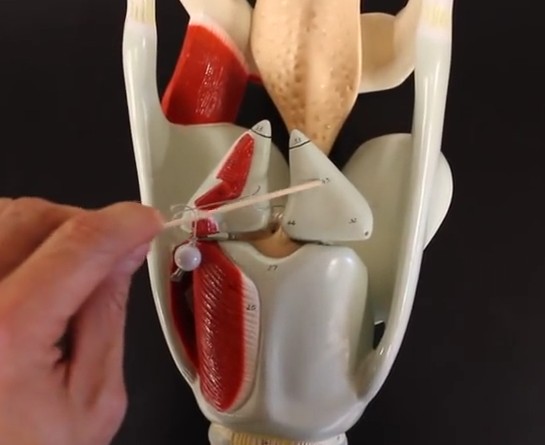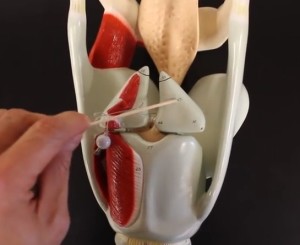The arytenoid cartilages are a pair of pyramid-shaped elastic and hyaline cartilage pieces that occur in the larynx. They play a major role in the creation of vocal sounds. The flexible and tough cartilage tissue is situated on the back section of the larynx, at the ends of the joints, and over the cricoid lamina which is a circular cartilage occurring at the bottom part of the voice box/larynx.
The arytenoid cartilage comprises of 2 of the 9 cartilage pieces that combine to form the larynx structure, with the others being, 1 thyroid and cricoid cartilages and 2 epiglottal, corniculate, and cuneiform pieces of cartilage. Each piece of the arytenoid cartilage is shaped like a pyramid and comes with a base, 3 surfaces, and an apex.
Arytenoid cartilage location (Picture)
Structure
- Apex: Each arytenoid cartilage apex is medialward, curved backwards, pointed, and surmounted by the corniculate cartilage, a conical and tiny cartilaginous nodule
- Base: Each arytenoid cartilage piece has a base that is broad and featuring a smooth concave surface for exchange of information with the cricoid cartilage. The anterior angle is known as the vocal process while the lateral angle is known as the muscular process.
- The surfaces: The back surface is smooth, triangular, and concave. It facilitates attachment to the transversus and Arytænoidei obliquus.
- The medial surface is enclosed in mucous membrane and is smooth, narrow, and flat. It forms the side border of the intercartilaginous section of the rima glottidis.
- The antero-lateral surface is rough and slightly convex. Next to the cartilage apex, it features a raised and circular colliculus, which in turn has a ridge that curves backwards initially and then down and onward to the vocal process. The lower section of this elevation intervenes between 2 foveæ or depressions; the lower section is oblong, while the upper section is triangular.
Arytenoid cartilage – function and processes
Both the arytenoid cartilage pieces feature 3 processes, including the muscular process and the vocal process.
- The muscular process: It projects laterally and is connected to the phonation muscles which facilitate arytenoid cartilage motion so as to adjust vocal ligament tension, thereby changing the pitch of sounds.
- The vocal process: It projects towards the front part of the body and is joined to the vocal cord or the vocal ligament, which in turn is made up of a thin sheet of elastic connective tissue called cricothyroid membrane or conus elasticus. This membrane is attached to the thyroid, cricoid, and arytenoid cartilages.
The thyroid, cricoid, and arytenoid cartilages also perform a secondary function of keeping the airways open through the larynx, thus permitting air to pass across the vocal cords.
Arytenoid cartilage dislocation
Arytenoid cartilage dislocation and AS or arytenoid subluxation are the common conditions associated with the arytenoid cartilage and often used to describe cricoarytenoid joint disruption. The latter (AS) is considered as being more common than the former. The conditions are believed to usually occur as complications resulting from instrumentation of the upper aerodigestive tract.
- When the arytenoid cartilage gets completely unattached from the joint space, then it is termed as arytenoid dislocation. It is generally caused due to serious trauma to the larynx area.
- Partial separation of the arytenoid cartilage within the joint is mostly likely to result in AS. It is regarded as a less serious condition that arytenoid cartilage dislocation.
Symptoms of arytenoid cartilage conditions
Patients may commonly suffer from hoarseness, vocal fatigue, breathy quality of the voice, and difficulties in projecting the voice.
- In rare cases, patients may experience odynophagia, dysphagia, coughing, sore throat, and respiratory problems which require airways management.
Causes of arytenoid cartilage dislocation
AS or arytenoid subluxation usually occurs as a complication of endotracheal intubation and instrumentation of the upper airway. Contact of the arytenoid cartilage with the cricoid cartilage results in disruption of its normal articulation, leading to partial glottic closure and decreased movement of the true vocal fold, which can be similar to paralysis of the true vocal fold.
- People with recent history of aerodigestive tract intubation or instrumentation are at greater risk to developing AS.
- The most common cause of AS is intubation trauma. It is less commonly caused due to penetration or blunt trauma to the neck. In some cases, it may occur due to whiplash injuries, direct laryngoscopy, or unknown causes.
- The cricoarytenoid joint may also weaken due to associated abnormalities such as acromegaly, rheumatic diseases, diabetes mellitus, laryngomalacia, prolonged corticosteroid use, and chronic renal failure. However, there is no definitive link between increased risk to AS development and the presence of anatomic anomalies or underling diseases.
- Arytenoid cartilage injuries caused due to external trauma to the neck is usually accompanied by other injuries of the larynx such as cricoid or thyroid cartilage fractures, mucosal tears, and hematoma occurrence.
Treatment of arytenoid cartilage conditions
Most cases of arytenoid cartilage conditions are usually treated via surgery. Early treatment comes with a better prognosis.
- Early treatment includes closed reduction of the dislocated arytenoid cartilage and direct laryngoscopy as well as steroid injections. Minor airway problems and laryngeal edema can be corrected via tracheotomy.
- Late treatment of AS often involves vocal fold medialization thyroplasty.
- Voice therapy helps during the rehabilitation process.


Накрутка Twitch Зрителей
накрутка зрителей Twitch
Шоколадная плитка открытка Новосибирск